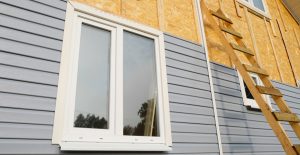 Your home’s siding does more than just enhance its appearance; it serves as the first line of defense against harsh weather conditions, moisture, and pests. Over time, though, even the best siding can wear out. Knowing the signs of damage or wear can help you decide when it’s time to replace it before the problem gets worse. This article will cover the five key signs that your vinyl siding may need to be replaced and how to spot them early.
Your home’s siding does more than just enhance its appearance; it serves as the first line of defense against harsh weather conditions, moisture, and pests. Over time, though, even the best siding can wear out. Knowing the signs of damage or wear can help you decide when it’s time to replace it before the problem gets worse. This article will cover the five key signs that your vinyl siding may need to be replaced and how to spot them early.
If you’re not sure about the condition of your siding, it’s always a good idea to reach out to professionals like GSO Contracting. Their team has years of experience with siding installations and replacements. Whether you need an inspection or full replacement, GSO Contracting can provide the expertise and quality service your home deserves.
- Cracks, Holes, or Visible Damage
One of the first signs that your siding needs replacing is visible damage. If you notice cracks, holes, or large dents in your siding, this is a sign that the siding has been compromised. These openings can allow water, air, or even pests to get behind the siding, which can cause serious damage to your home’s structure.
It’s also important to check for small cracks or gaps around corners, windows, or where the siding meets the foundation. These can expand over time, causing further damage. Even if the damage seems minor, it’s always best to have it checked by a professional contractor who can determine if a replacement is necessary.
- Warping or Buckling
Siding can become warped or buckled due to exposure to moisture or extreme weather conditions. When siding becomes warped, it loses its ability to protect your home from the elements. In some cases, moisture that gets trapped behind the siding can cause it to swell, bend, or buckle out of place.
Warped siding not only looks unsightly but also reduces the energy efficiency of your home. Gaps between warped panels can allow drafts to enter, making your home less comfortable and causing your heating and cooling bills to rise. If you notice any warped, buckled, or uneven sections, it’s time to have them inspected and possibly replaced.
- Fading or Discoloration
Over time, siding can fade due to prolonged exposure to the sun’s UV rays. If your siding has faded, it could be a sign of age and wear. While fading doesn’t always mean that your siding is no longer effective, it can make your home look outdated and reduce its curb appeal.
Look for uneven fading across the surface, as this can signal that your siding is reaching the end of its life. If the fading is accompanied by other signs of damage, such as cracks or warping, it’s likely time for a replacement. Additionally, newer siding materials often offer better resistance to fading and UV damage, so replacing old siding can be a great way to improve both the look and function of your home.
- Mold or Mildew Growth
Mold and mildew growth on your siding is a clear sign that moisture is getting trapped behind it. This can happen if the siding is cracked, warped, or has gaps that allow water to seep in. Mold and mildew thrive in damp environments, and if left untreated, they can lead to health issues for your family and even cause structural damage to your home.
You may notice dark spots or streaks of mold and mildew, particularly in areas that are shaded or receive less sunlight. If you’re seeing mold or mildew regularly on your siding, it’s time to investigate the underlying cause. Often, this indicates that the siding is no longer properly protecting your home from moisture and should be replaced.
- Increased Energy Bills
If your energy bills have been steadily rising, your siding could be to blame. Older siding materials or damaged siding can cause drafts and leaks in your home. When your home isn’t properly insulated due to gaps or damaged siding, your heating and cooling systems have to work harder to maintain a comfortable temperature.
Newer siding materials provide better insulation and help prevent air leaks, leading to improved energy efficiency. If you’ve noticed a spike in your utility costs and suspect that your siding is contributing to the problem, it may be worth considering an upgrade to more energy-efficient siding options.
Call GSO Contracting for an Expert Inspection
If you’ve noticed any of these signs in your siding, it’s important to take action sooner rather than later. Ignoring these issues can lead to more significant damage, higher repair costs, and even potential structural problems. A professional siding contractor like GSO Contracting can provide an expert inspection, help you understand the condition of your siding, and recommend the best solution for your home.
GSO Contracting specializes in siding replacements and installations, ensuring that your home is well-protected from the elements and looking great for years to come. Don’t wait until the problem gets worse—contact GSO Contracting today for a free quote and consultation!
